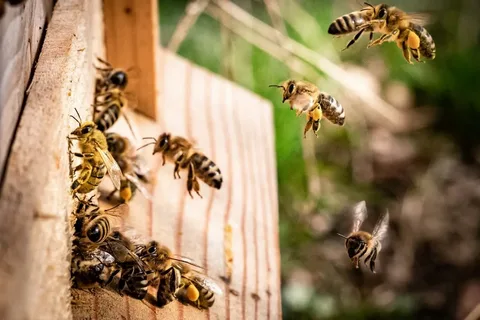Understanding Bee Foraging Patterns: When and Where Infestations Occur
What Are Foraging Patterns?
Foraging patterns refer to the specific behaviors and routines bees follow when searching for food, mainly nectar and pollen. These patterns are not random; bees are highly organized, often returning to the same locations day after day. They are also incredibly efficient, focusing their energy on areas rich in flowering plants. Foraging patterns are essential for a bee colony’s survival, as they ensure that the colony has enough food to thrive and sustain itself.
During the foraging process, worker bees leave the hive early in the morning and spend most of their day collecting resources. The distance a bee travels can vary, but bees have been known to fly up to five miles in search of food. They navigate based on environmental cues, including the sun, landmarks, and even the Earth’s magnetic field.
Seasonal Foraging Behavior
Bee foraging patterns change throughout the year, as different seasons bring varying levels of food availability. In spring and summer, when flowers are abundant, bees are more active. These seasons are critical for bees as they need to collect as much nectar and pollen as possible to store for the colder months.
However, during late summer and early fall, as plants begin to die off, bees may start to search further afield for food. This period of scarcity can lead to more frequent encounters between bees and humans, as bees may be attracted to gardens, outdoor dining areas, or even homes where they detect sugary substances or flowering plants. These heightened foraging activities may increase the likelihood of infestations.
Why Infestations Occur
Infestations typically occur when bees find suitable locations near human dwellings to establish new hives. This often happens when bees’ natural habitat is disrupted, or when they are attracted to human-made structures that mimic natural shelters, such as attics, walls, and chimneys. Understanding foraging patterns helps explain why bees might target certain areas for building hives.
In urban areas like San Diego County, bees may be drawn to residential spaces due to the proximity of gardens, orchards, or even waste that provides food sources. The presence of flowering plants and accessible water sources can make these areas attractive for bees seeking a new home.
Environmental Factors Influencing Foraging
The environment plays a major role in shaping bee foraging patterns. Temperature, humidity, and weather conditions significantly impact how far bees will travel and how frequently they forage. Bees prefer foraging during warm, sunny days when flowers are open and producing nectar. Rainy or windy days, on the other hand, can limit their activity as it becomes harder for bees to navigate and access flowers.
In San Diego County, where the climate is generally mild and favorable for bees, they are active most of the year. This extended foraging period increases the risk of infestations, as bees may search for new nesting sites if their current habitat becomes unsuitable.
Common Locations for Bee Infestations
Bee infestations are most likely to occur in areas where bees find abundant food sources and safe nesting spots. Urban gardens, orchards, and areas near forests are common sites for bees to forage and establish hives. Additionally, areas with a lot of water sources, such as fountains or ponds, can attract bees.
In residential settings, bees may be drawn to eaves, gutters, and cracks in walls where they can find shelter. If you notice bees frequently foraging near your property, it may be a sign that they are scouting for a place to build a hive. Bees tend to return to areas where they have successfully found food, which increases the likelihood of an infestation.
Preventing Bee Infestations
Preventing bee infestations starts with understanding foraging patterns and taking proactive steps to limit attractants around your property. One of the simplest methods is to minimize or control flowering plants close to your home, especially during peak foraging seasons in spring and summer. Removing excess standing water, covering trash bins, and sealing any gaps in your home’s exterior can also help prevent bees from entering and nesting.
If you suspect a bee infestation on your property, it’s essential to consult a professional for safe removal. Many homeowners in San Diego County have experienced bee issues due to the region’s favorable climate for these insects. When bees are foraging near homes or attempting to establish a hive in residential areas, working with a bee removal service in San Diego County is crucial to handling the situation safely and ethically. Professional services not only remove the bees but also relocate them when possible to protect their critical role in the ecosystem.
The Importance of Ethical Bee Removal
Given the critical role bees play in pollination and environmental health, ethical bee removal services prioritize relocation over extermination. Understanding the foraging patterns of bees allows these services to assess the behavior of the colony and determine the best methods for removal. Proper relocation ensures that bees can continue contributing to their environment without causing harm or disturbance to human spaces.
In regions like San Diego County, where bees are active throughout the year, bee removal services are often in demand, especially as urbanization continues to encroach on natural habitats. By understanding where and when bees forage, property owners can minimize the chances of infestations and avoid the need for more drastic measures.
Conclusion
Understanding bee foraging patterns provides valuable insight into how and why infestations occur. Bees are highly organized creatures whose behavior is influenced by factors such as the seasons, climate, and available resources. In regions with favorable conditions, such as San Diego County, foraging behavior can sometimes lead to infestations, especially when bees find ample food sources near human homes. Taking preventive measures, such as limiting attractants and consulting professional bee removal services in San Diego County, can help mitigate the risks of bee infestations while respecting the essential role bees play in the environment.






